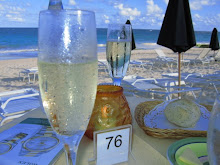
I am half-Greek; Cypriot to be more specific. Pop's ancestors are from Cyprus, an island off the coast of Turkey. It's an independent country but half is occupied by peoples of Greek ancestry, the other half by Turkish. It has a long and sometimes violent history; my grandparents came to the United States in the 1950s at which point the British occupied the country.
The Greeks, Turkish, Lebanese, Persians, and Jordanians all share dishes that vary slightly from region to region. The shish kebab and keftedes Grandpa make have almost identical counterparts in these cultures. Grandma's reportoire of Greek desserts when I was a child included kourabiedes, which bear striking resemblance to Mexican wedding cookies. It's fascinating how food crosses regions and cultures, truly binding us together. But, I digress.
Baklava is not a dessert Grandma made often in my childhood. She made other filo desserts including galaktoboureko (filo filled with custard and covered in fragrant sugar syrup- think French mille feuille) and kadaifi (shredded fillo rolled around chopped nuts and spices, bathed in syrup). The aforementioned kourabiedes cookies are the favorite of my brothers, who'd happily fluff powdered sugar everywhere.
Despite that, baklava is probably the most well-known Greek sweet. NH really enjoys it and orders horrid squares of it at any Mediterranean restaurant, including the awful chain down the street from our home. He has hinted to me that he would like it if I made some sometime.
It's not difficult to make; it's merely time-consuming. I decided on a whim to make some baklava one morning, as a surprise. Filo dough is sold frozen and must be thawed for several hours before use. Because of my whim, I did not leave enough time for this step and it's crucial to keeping the dough in tact. I muscled through ok, but I don't recommend this. It took even longer to assemble the baklava and it was definitely tricky. In the future I will surely plan ahead, but in the end you couldn't tell I had made this mistake.
There are many recipes for baklava, but they have mostly minor differences. The nuts may vary and the syrup flavorings may change by taste/region, but most contain the same ingredients and measurements. Baklava is definitely worth making at home rather than purchasing. It's best when very fresh.
Many tastes vary on how much syrup to use; I'm convinced people think a baklava is good or bad based on their preference for syrup and how much the particular cook used. I prefer mine with much less syrup and a bit of crunch to the toasted filo and nuts. NH likes lots of syrup, a soggy and sweet pastry with little or no crunch. It might take you a few tries to determine what you and yours prefer.
Homemade Baklava
1 package of frozen Filo dough (16 ounces), defrosted in the fridge for about 8 hours
1 pound chopped nuts*
1 cup Butter, melted
1 tsp ground Cinnamon

1 cup water
1 cup white Sugar
1 tsp Vanilla extract
1/2 cup Honey
optional additional flavorings: lemon zest, orange blossom water, rose water
*Walnuts are the traditional baklava filling. However, I find a combination of nuts provides more complexity of flavor. I used almonds, hazelnuts, and walnuts, but you could also use pistachios or even pecans. Any combination of what you have on hand could work.
Preheat your oven to 350 degrees Fahrenheit.
Butter the bottom and sides of a 9x13 glass baking dish with a pastry brush.
Process the nuts and cinnamon in a food processor until fine, and set aside. Unroll the filo dough; if needed cut the whole stack to fit your dish.
Place a dampened cloth over the filo dough to prevent it from drying out. Make sure to recover every time you take another sheet from the pile.
Place two sheets in the pan and brush with butter thoroughly. Sprinkle some of the nut mixture over the dough. Place two more sheets of filo over the nuts and brush with butter. Repeat until all of the nut mixture has been used. Place any remaining filo on top and brush with butter.
With a very sharp knife, cut the baklava in diamond or square shapes, making sure to cut all the way to the bottom of the pan. Bake for about 50 minutes until golden brown and crisp.
To make the sugar syrup, boil the sugar and water until the sugar is dissolved. Add the vanilla, honey, and any other flavorings you choose. Simmer for about 20 minutes until the syrup thickens slightly. Allow to cool a little.
Remove the baklava from the oven and immediately pour the desired amount of syrup. The whole batch will create the soggy sweet baklava that some prefer; use about 1/3 to 1/2 if you prefer a crunchy, more dry pastry. Allow to cool.
Serves 18












No comments:
Post a Comment